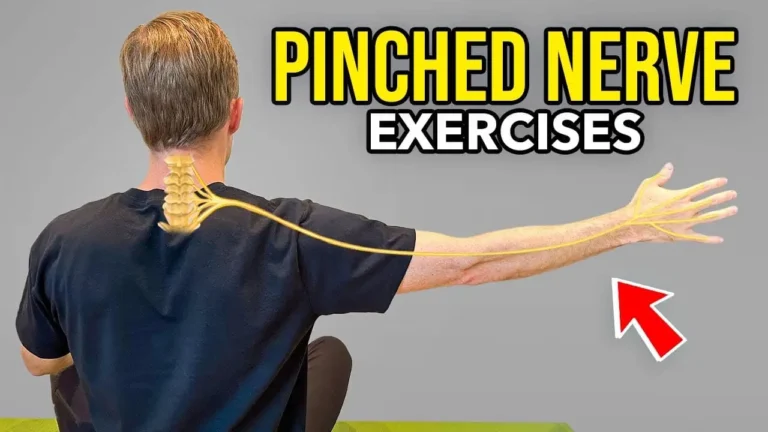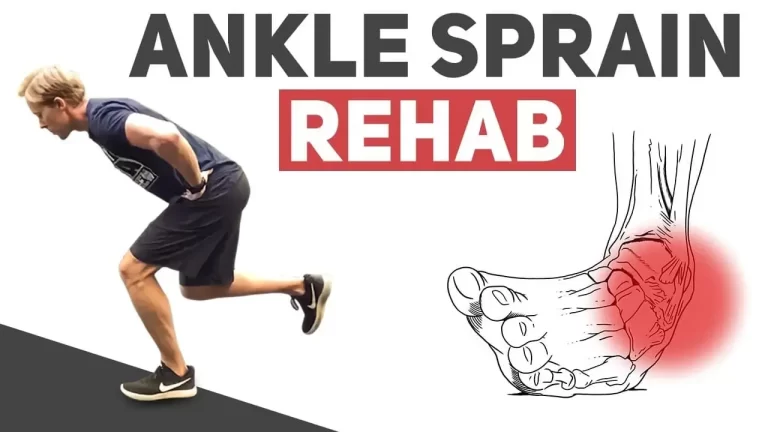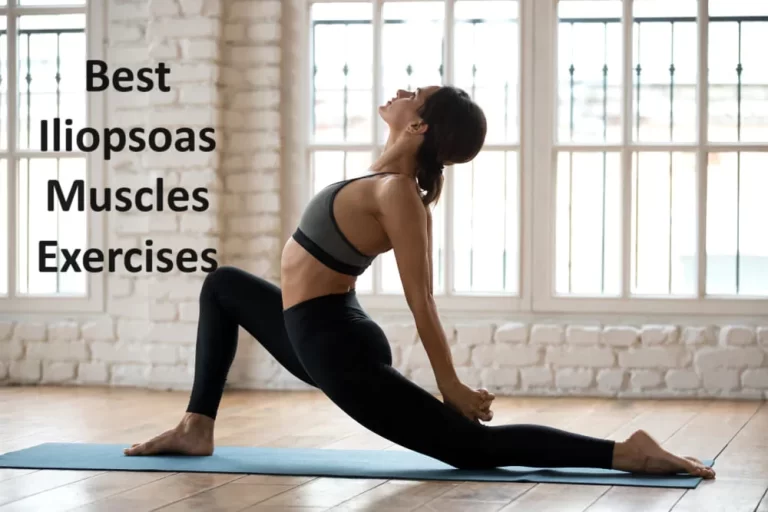14 Best Deltoid Exercises With Dumbbells
Introduction:
Developing your shoulders is probably one of your top goals if you’re trying to gain muscle mass. Deltoid Exercises With Dumbbells are one of the finest ways to earn large, dense shoulders and gain a significant amount of shoulder mass.
Compared to barbells and machines, many dumbbell movements provide you with a much wider range of motion. Increased range of motion may increase mobility and help in muscular growth.
You might be concentrating on developing your triceps and biceps throughout your arm exercises. However, shoulder strength is as vital. Additionally, dumbbell shoulder exercises are a great approach to strengthen the larger shoulder muscles as well as the smaller ones that support these important joints.
Although most dumbbell shoulder exercises focus on the deltoids, a well-rounded workout will also strengthen the minor stabilizing muscles of the shoulder joint. Your rotator cuff, which stabilizes your shoulder joint, is made up of these four smaller muscles.
Benefits of exercise:
Exercises using dumbbells to strengthen the deltoid muscles improve strength, stability, posture, and athletic performance in addition to increasing shoulder development.
Growth of Muscles and Appearance
- All three of the deltoid’s heads are worked by dumbbell movements like shoulder presses and lateral raises.
- Enhances the form of the upper body by encouraging rounder, broader shoulders.
- Unilateral training is possible with dumbbells since each arm may be used independently.
- Helps in resolving left and right shoulder imbalances.
Joint Stability and Health
- Training with dumbbells works stabilizer muscles, such as the rotator cuff.
- Increases the stability of the joints and scapular control.
More Power and Strength
- Strengthening exercises that are employed in daily motions include dumbbell shoulder presses.
- Strengthens the capacity to lift weights safely, which is crucial for labor-intensive occupations, weightlifting, and athletics.
Improved Athletic Performance
- Sports like baseball, swimming, tennis, and volleyball require strong shoulders.
- Exercises using dumbbell deltoid muscles improve force production, coordination, and injury resistance.
Improved Control and Range of Motion
- Compared to barbells or machines, dumbbells provide a more organic movement route.
- Lowers joint strain and encourages better shoulder mechanics.
Postural Improvements
- The slouched posture caused by extended computer usage or sitting is countered with workouts for the rear deltoids.
- Helps keep the shoulders in position and pulls by strengthening the upper back and shoulder stabilizers.
When starting an exercise program, take these precautions:
It’s important to think about a few safety precautions before beginning any fitness program in order to ensure your well-being and optimize the benefits. To find out which exercises are best for your particular issue, speak with your doctor or physical therapist.
You should pay attention to your body and refrain from overexerting yourself. Mild discomfort is common during exercise, but if it worsens, it may be a sign that you’re exerting yourself too much. Once you can tolerate greater pain, work your way up to increasingly challenging exercises from low-impact ones.
If you’re unclear about how to carry out a fitness regimen, get advice from a trained expert. To properly prepare your joints and muscles for the workout, warm up before starting any activity.
How to Get Your Shoulders Warmed Up Before Exercise:
As usual, warm up your body before engaging in any kind of physical activity. Getting your shoulders ready for exercise is essential to avoiding injuries and improving your performance.
“Warm-up exercises that improve blood flow and shoulder joint flexibility include arm circles, shoulder rolls, and mild stretches.” Additionally, using the right technique when completing mild sets of the targeted exercises helps activate and prime the shoulder muscles for more strenuous actions. Before using dumbbells for these exercises, don’t be scared to perform them with just your body weight.
Deltoid Exercises With Dumbbells:
These workouts targeted at the deltoids will enhance your body and improve the general strength and mobility of your shoulders and upper body.
Dumbbell Front Raise
- Take a standing position on the floor.
- Grab a dumbbell pair.
- Keep your back straight.
- After taking a breath, lift your arms horizontally, engage your abs, and hold the dumbbells in a pronated grip.
- Maintain a small bend in your elbow.
- Hold this position for a few seconds.
- Then return to your neutral position.
- Then relax.
- Repeat these exercises 5 to 10 times.
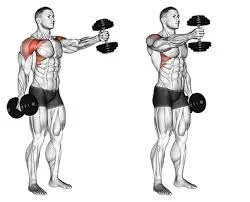
Arnold press
- Your feet should be hip-width apart.
- Hold a pair of dumbbells at your shoulders.
- In a single motion, turn your forearms such that the palms face front and open your elbows to the sides.
- Lift the dumbbells, keeping your arms straight.
- Hold this position for a few seconds.
- Then turn the motion around to start over.
- Then relax.
- Repeat these exercises 5 to 10 times.
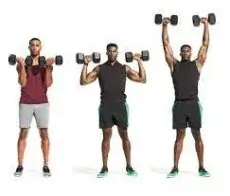
Dumbbell shoulder press
- Put your feet shoulder-width apart.
- Keep your knees slightly bent when standing.
- Your arms should be bent and palms facing each other while you hold a pair of dumbbells just outside your shoulders.
- Press both dumbbells up while your arms are straight and the weights are elevated.
- Hold this position for a few seconds.
- Then return to your neutral position.
- Then relax.
- Repeat these exercises 5 to 10 times.

Dumbbell shrug
- After positioning the dumbbells on each side of your body, get to your feet.
- Breathe in, bend forward, and take a neutral hold on the dumbbells.
- To raise the shoulders, contract the traps.
- Hold this position for a few seconds.
- Then return to your neutral position.
- Then relax.
- Repeat these exercises 5 to 10 times.
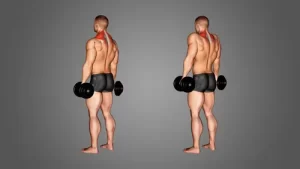
Bent-over lateral raise
- To begin, stand with your feet shoulder-width apart and pick up a pair of dumbbells.
- Keep your knees bent just a bit.
- Your head and neck should be in a neutral position, with your shoulders precisely above your hips.
- For stability, balance your weight evenly and use your feet to grasp the floor.
- Make sure your upper body is at a 45-degree angle and your shins are vertical.
- Your position should feel supported by your legs.
- Maintain a long arm position with your hands facing one another and your elbows slightly bent.
- Squeeze your posterior deltoids to start the upward movement while keeping your elbows slightly bent and your position good.
- Make sure your arms and back are level by raising them.
- You should raise the dumbbells while contracting your shoulder blades.
- Your upper arms should be higher than your hands.
- Hold this position for a few seconds.
- Lower your arms gradually until the dumbbells are back where they were before.
- Then return to your neutral position.
- Then relax.
- Repeat these exercises 5 to 10 times.
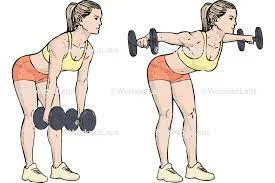
Single-arm push press
- Ensure that your feet are shoulder-width apart and stand upright.
- With the palm facing inside, place your elbow slightly in front of your chest while holding a dumbbell at shoulder height.
- Maintain your non-working hand on your hip or out for balance while bracing your core.
- Put your knees and hips slightly bent, and do a quick drop.
- Maintain a straight body and planted heels.
- Extend your hips and knees gently while applying effort upward.
- In a single, flowing motion, press the dumbbell straight overhead as you stand up.
- A locked-out elbow, a dumbbell over your shoulder, and a tight core are good ways to finish.
- Reduce the controlled dumbbell to shoulder height.
- Then return to your neutral position.
- Then relax.
- Repeat these exercises 5 to 10 times.

Dumbbell Thrusters
- When you initially stand, put your feet shoulder-width out.
- Grasp a set of dumbbells.
- Lift the weights until they reach your shoulders while keeping your elbows up.
- Squeeze your glutes, abdomen, and shoulder blades to generate tension throughout your entire body.
- Drop yourself into a squat.
- For this exercise, try for a drop just below parallel.
- Raise yourself from the bottom of the squat by pushing up through your heels.
- Strongly lift the weights as you jump to your feet.
- Then return to your neutral position.
- Then relax.
- Repeat these exercises 5 to 10 times.

Incline dumbbell press
- Holding two dumbbells, slowly lean back and lift your arms until the weights are head-high.
- Pull your shoulder blades into the bench, then push through your feet to straighten them.
- This should help to protect the shoulder joint by forming an arch in your lower back.
- Breathe deeply and hold it directly above your head.
- Lower the dumbbells till they just touch your mid-chest as you start the repetitions.
- Being careful to maintain your elbows tucked in rather than letting them flare out.
- Straighten your arms and push the dumbbells on your chest with your feet and arms.
- Then return to your neutral position.
- Then relax.
- Repeat these exercises 5 to 10 times.
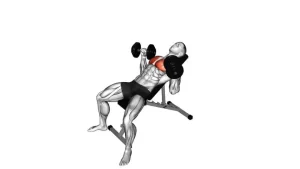
Dumbbell scaption
- Maintain a shoulder-width distance between your feet.
- Make sure you have a tall, upright stance with your shoulders pushed back and down.
- Maintain a neutral palm position while holding a light dumbbell in each hand.
- Use your glutes and core.
- Raise both dumbbells so that your arms form a Y at a 45-degree angle.
- Hold this position for a few seconds.
- Then return to your neutral position.
- Then relax.
- Repeat these exercises 5 to 10 times.
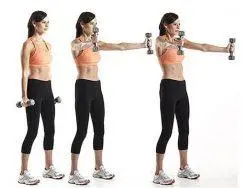
Dumbbell z-press
- First, sit with your legs out in front of you on the floor.
- Next, hold a dumbbell in each hand.
- With your feet level on the floor and your knees bent, your heels should be close to your glutes.
- Raise the dumbbells to your shoulders while keeping your elbows pointed forward and your palms facing one another.
- Raise and gently recline the dumbbells until your arms are straight and they are exactly over your shoulders.
- With your elbows pointing forward and your core active, lower the dumbbells back down to your shoulders.
- Then return to your neutral position.
- Then relax.
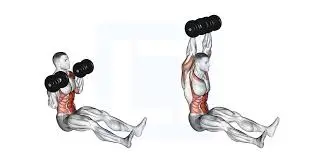
Dumbbell Upright Row
- The dumbbells should be held at arm’s length by your thighs, palms facing you.
- Be sure that your grasp is a little bit less than shoulder width.
- Dumbbells should be kept close to your body as you raise them gradually with your elbows.
- Make sure your elbows are higher than your forearms throughout the lift.
- Hold gently at the top of the exercise once the dumbbells are level with your collarbone.
- Return the dumbbells slowly to your thighs.
- Then return to your neutral position.
- Then relax.
- Repeat these exercises 5 to 10 times.
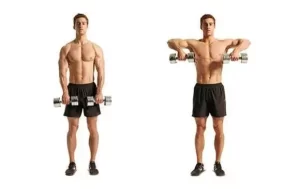
Reverse Fly
- Maintain a shoulder-width distance between your feet while keeping dumbbells by your sides.
- Your chest will come forward and be nearly parallel to the floor if you tilt your hips back.
- Maintain a firm core, a straight back, and a minor knee bend while letting the weights hang straight down.
- Next, raise both arms to your sides.
- Your elbows should remain gently bent.
- Pulling the shoulder blades in the direction of the spine will squeeze them together.
- As you take a breath, return the weight to its initial position.
- Throughout the exercise, keep your chin tucked in to maintain a neutral spine and avoid hunching your shoulders.
- Then return to your neutral position.
- Then relax.
- Repeat these exercises 5 to 10 times.
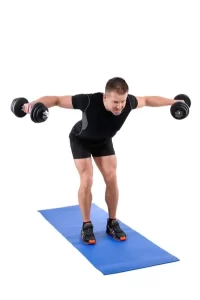
Dumbbell Y Raise
- On a bench that is inclined, position yourself chest-down.
- With your palms facing one another, let your arms drop straight down.
- To get your arms with your shoulders, tighten your core, and elevate them to a 30-degree angle concerning your body.
- Throughout, make sure your arms remain straight.
- Hold this position for a few seconds.
- Then return to your neutral position.
- Then relax.
- Repeat these exercises 5 to 10 times.
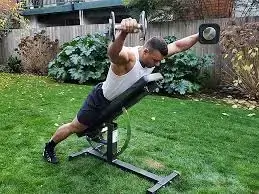
Single-arm bent-over row
- Lean over and place your left knee and left hand on a bench to support your body weight while holding a dumbbell in your right hand.
- Then place your hand beneath your shoulder.
- To make your body more rigid and your spine more stable, gently tighten your core and abdominal muscles.
- Make sure your head is in line with your spine and your back is flat.
- Keep your shoulders in this position throughout the workout by lowering and retracting your scapulae without arching your lower back.
- While holding the dumbbell, extend your right arm towards the floor, preventing your shoulders from moving towards the floor or your body from rotating.
- Bend your elbow and draw your upper arm back as you slowly raise the dumbbell after exhaling.
- Pull the dumbbell up until you can no longer raise it without turning your torso, keeping your arm near the side of your body.
- Throughout the lift, refrain from turning your body or shifting your spine position.
- Then return to your neutral position.
- Then relax.
- Repeat these exercises 5 to 10 times.
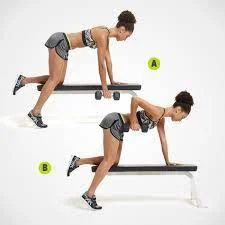
What safety measures need to be taken when exercising?
Safety is essential when doing dumbbell deltoid workouts to avoid injuries, particularly to the shoulders, which are very flexible yet rather unstable joints.
Here is a comprehensive guide on safety precautions you should follow before, during, and after dumbbell deltoid workouts:
Get your shoulders warmed up.
- Engage in gentle aerobics for five to ten minutes.
- Incorporate dynamic shoulder motions, such as shoulder rolls and arm circles.
Select the Right Weight
- Pick a weight that you can manage between 10 and 15 repetitions.
- Don’t overdo it; tight technique and moderate weight work best for deltoid muscles.
- Only increase the weight after you can complete each repetition properly.
Stay away from dangerous angles.
- When performing shoulder presses, do not place the weights too low or behind the neck.
- To preserve the joint, keep lateral rises slightly in front of the body.
Get All Three Deltoid Heads Trained.
- Rear deltoids are essential for balance and posture, so don’t ignore them.
Avoid Overworking
- Let your shoulders rest because they play a role in a lot of complex actions.
- Don’t do shoulder-focused exercises more than twice or three times a week.
- Make sure you take a 48-hour break in between deltoid exercises.
Keep the Rotator Cuff safe.
- As part of your warm-up or cool-down, incorporate workouts that involve external rotation.
- Every week, strengthen the rotator cuff by using dumbbells or a light band.
Use the Correct Form
- Maintain a neutral spine.
- Keep your elbows bent slightly and avoid locking them.
- Move slowly and carefully; avoid jerking or swinging.
- Dumbbells should be kept at a safe distance.
Make Use of a Mirror or Video
- To keep an eye on shoulder posture and form, use mirrors.
- To guarantee proper posture and prevent imbalances, record yourself if you are lifting alone.
Stretch and cool down.
- After working out, stretch your front, side, and back delts.
- Incorporate exercises for the chest and upper back to preserve posture and shoulder balance.
When did you stop exercising?
The following are the primary signs that it’s time to stop your current movement or exercise:
Muscle Atrophy or Ineffectiveness
- It is impossible to do repetitions correctly.
- Muscles feel weak or worn out.
Sharp or Joint Pain
- Stop right away if you get neck, elbow, or shoulder pain.
- Muscle fatigue is not the same as pain; pay attention to your body.
An excessive number of repetitions
- You’ve completed two to four deltoid exercises and three to five sets of each exercise.
- Shoulders are small, sensitive muscles, so more isn’t always better.
Pain, numbness, or tingling that radiates
Stop immediately if you encounter:
- The forearm or fingers feel numb.
Poor Form
- Your back is arched, or you’re swinging weights.
- Injury risk increases when control is lost.
After several weeks, there has been no progress.
- If your strength, stability, or soreness doesn’t change after many weeks of regular practice.
Summary:
For everyday activities like lifting a kid, carrying groceries, and raising your arms, the deltoid muscles that cover the front, back, and side of the shoulder joint are essential.
Better posture, increased upper-body strength, and improved performance in a variety of physical activities are all affected by strong deltoids. Strong deltoids can help prevent injuries by giving the shoulder joint better support and stability, whether you’re lifting weights, playing sports, or going about your everyday business.
FAQ:
Can I use just dumbbells to develop large shoulders?
Yes. By allowing unilateral exercise (training each side separately) and a full range of motion, dumbbells can promote balanced strength and development. The key is constant exercise and progressive overload.
How frequently should I work out my deltoids each week?
For the majority of lifters:
Newbies: once or twice a week
Intermediates: two to three times a week
Can side deltoids be strengthened with dumbbell lateral raises?
Indeed. One of the best exercises for developing and isolating the lateral deltoid, which helps to create wider shoulders, is the dumbbell lateral raise.
Which is preferable for doing exercises: standing or sitting?
Both are advantageous: Standing strengthens the core and improves functional strength. Sitting: More deltoids are isolated.
What are common mistakes made when exercising the deltoid muscles with dumbbells?
Swinging and using too much weight
Back arching or bad posture
Not working the back deltoids
What is the most effective deltoid exercise?
To train the deltoid muscle, the most popular exercises are shoulder presses, lateral rises, and rear deltoid raises. To guarantee that the shoulder joint is properly stabilized and that the muscle is being treated correctly, it is essential to perform these workouts correctly.
What are the best dumbbell exercises for the deltoid muscles?
Dumbbell Reverse Fly
Dumbbell Upright Row
Dumbbell z-press
Incline dumbbell press
Dumbbell Front Raise
Dumbbell Overhead press
Dumbbell Bent-over lateral raise
References:
- Tracey, A. February 25, 2025. The Top 12 Shoulder Dumbbell Exercises. Health of men. The best dumbbell shoulder exercises can be found at https://www.menshealth.com/uk/fitness/a61944804/.
- Shoulder Workouts for Mass | Best Dumbbell Shoulder Exercises – MYPROTEINTM. (2022, May 6). MYPROTEINTM. https://www.myprotein.co.in/blog/training/dumbbell-exercises-mass/ for shoulder training
- Adil, A. (November 2, 2023). Five shoulder workouts using dumbbells : https://gripzilla.co/blogs/news/srsltid=AfmBOoofFeLBH81hGZrJSqiNA98c63FisE7dQgpvjL-C0kHSLakK7NK9
- Kirkup-Lee, A. February 28, 2025. The top six rear delt workouts for shoulder strength. Gymshark. The best rear-delt exercises can be found at https://row.gymshark.com/blog/article
- Image 10, Manual for Lifting. April 24, 2023. The form, advantages, and guide of the dumbbell Z press. Dumbbell-Z-Press: https://liftmanual.com
14 Best Deltoid Exercises With Dumbbells




